ECU FBL5010 Semester 2: Communication Skills for Strategic Development
VerifiedAdded on 2022/11/14
|6
|1444
|395
Essay
AI Summary
This essay delves into the critical role of communication skills in fostering strategic development within organizational structures and cultures. It emphasizes the significance of effective communication, encompassing written, verbal, and non-verbal modes, for the seamless flow of information between senders and receivers. The essay highlights how communication skills are essential for implementing strategic goals, enhancing employee performance, and establishing open communication channels. It explores the importance of ethical considerations across different organizational cultures and the impact of organizational governance on performance. The essay also discusses the evolution of communication in the digital age, including the use of social media and intranet systems, and the necessity of adapting to cultural diversity to avoid communication hindrances. Ultimately, the essay concludes that strong communication skills are fundamental to achieving strategic objectives and fostering a motivated, connected workforce, which in turn leads to organizational success. The essay provides a comprehensive overview of how communication is crucial in management functions such as planning, staffing, organizing, and controlling.
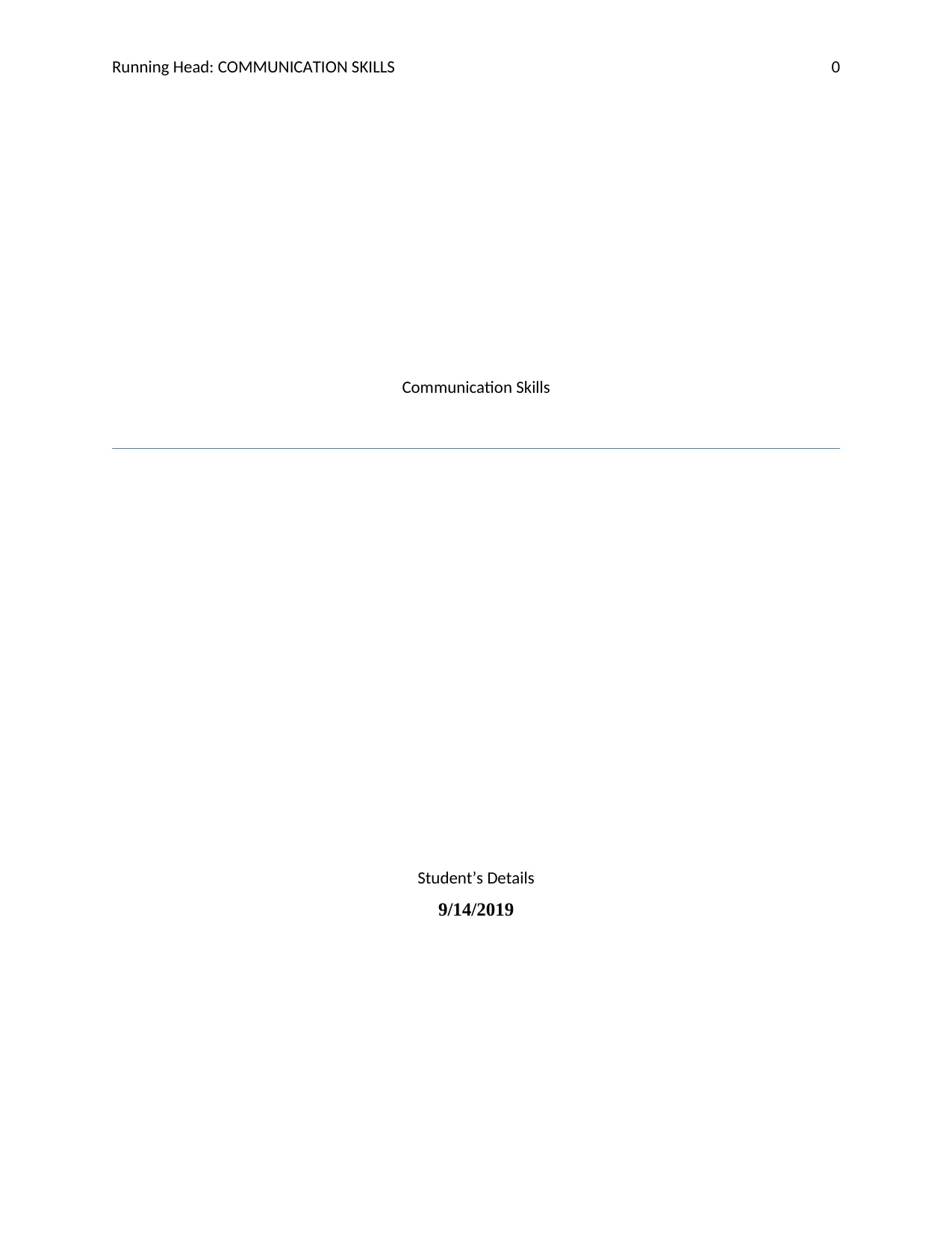
Running Head: COMMUNICATION SKILLS 0
Communication Skills
Student’s Details
9/14/2019
Communication Skills
Student’s Details
9/14/2019
Paraphrase This Document
Need a fresh take? Get an instant paraphrase of this document with our AI Paraphraser
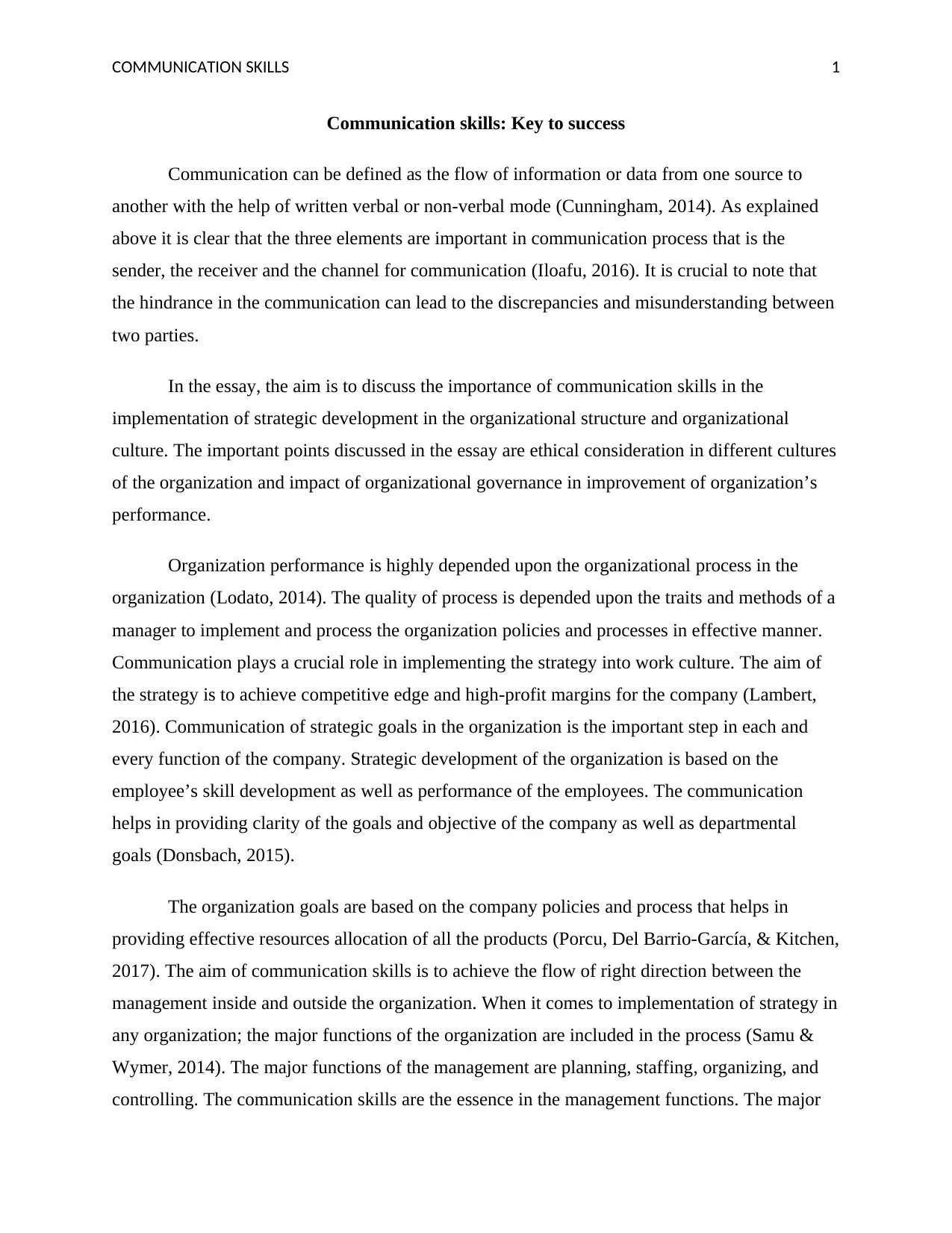
COMMUNICATION SKILLS 1
Communication skills: Key to success
Communication can be defined as the flow of information or data from one source to
another with the help of written verbal or non-verbal mode (Cunningham, 2014). As explained
above it is clear that the three elements are important in communication process that is the
sender, the receiver and the channel for communication (Iloafu, 2016). It is crucial to note that
the hindrance in the communication can lead to the discrepancies and misunderstanding between
two parties.
In the essay, the aim is to discuss the importance of communication skills in the
implementation of strategic development in the organizational structure and organizational
culture. The important points discussed in the essay are ethical consideration in different cultures
of the organization and impact of organizational governance in improvement of organization’s
performance.
Organization performance is highly depended upon the organizational process in the
organization (Lodato, 2014). The quality of process is depended upon the traits and methods of a
manager to implement and process the organization policies and processes in effective manner.
Communication plays a crucial role in implementing the strategy into work culture. The aim of
the strategy is to achieve competitive edge and high-profit margins for the company (Lambert,
2016). Communication of strategic goals in the organization is the important step in each and
every function of the company. Strategic development of the organization is based on the
employee’s skill development as well as performance of the employees. The communication
helps in providing clarity of the goals and objective of the company as well as departmental
goals (Donsbach, 2015).
The organization goals are based on the company policies and process that helps in
providing effective resources allocation of all the products (Porcu, Del Barrio-García, & Kitchen,
2017). The aim of communication skills is to achieve the flow of right direction between the
management inside and outside the organization. When it comes to implementation of strategy in
any organization; the major functions of the organization are included in the process (Samu &
Wymer, 2014). The major functions of the management are planning, staffing, organizing, and
controlling. The communication skills are the essence in the management functions. The major
Communication skills: Key to success
Communication can be defined as the flow of information or data from one source to
another with the help of written verbal or non-verbal mode (Cunningham, 2014). As explained
above it is clear that the three elements are important in communication process that is the
sender, the receiver and the channel for communication (Iloafu, 2016). It is crucial to note that
the hindrance in the communication can lead to the discrepancies and misunderstanding between
two parties.
In the essay, the aim is to discuss the importance of communication skills in the
implementation of strategic development in the organizational structure and organizational
culture. The important points discussed in the essay are ethical consideration in different cultures
of the organization and impact of organizational governance in improvement of organization’s
performance.
Organization performance is highly depended upon the organizational process in the
organization (Lodato, 2014). The quality of process is depended upon the traits and methods of a
manager to implement and process the organization policies and processes in effective manner.
Communication plays a crucial role in implementing the strategy into work culture. The aim of
the strategy is to achieve competitive edge and high-profit margins for the company (Lambert,
2016). Communication of strategic goals in the organization is the important step in each and
every function of the company. Strategic development of the organization is based on the
employee’s skill development as well as performance of the employees. The communication
helps in providing clarity of the goals and objective of the company as well as departmental
goals (Donsbach, 2015).
The organization goals are based on the company policies and process that helps in
providing effective resources allocation of all the products (Porcu, Del Barrio-García, & Kitchen,
2017). The aim of communication skills is to achieve the flow of right direction between the
management inside and outside the organization. When it comes to implementation of strategy in
any organization; the major functions of the organization are included in the process (Samu &
Wymer, 2014). The major functions of the management are planning, staffing, organizing, and
controlling. The communication skills are the essence in the management functions. The major
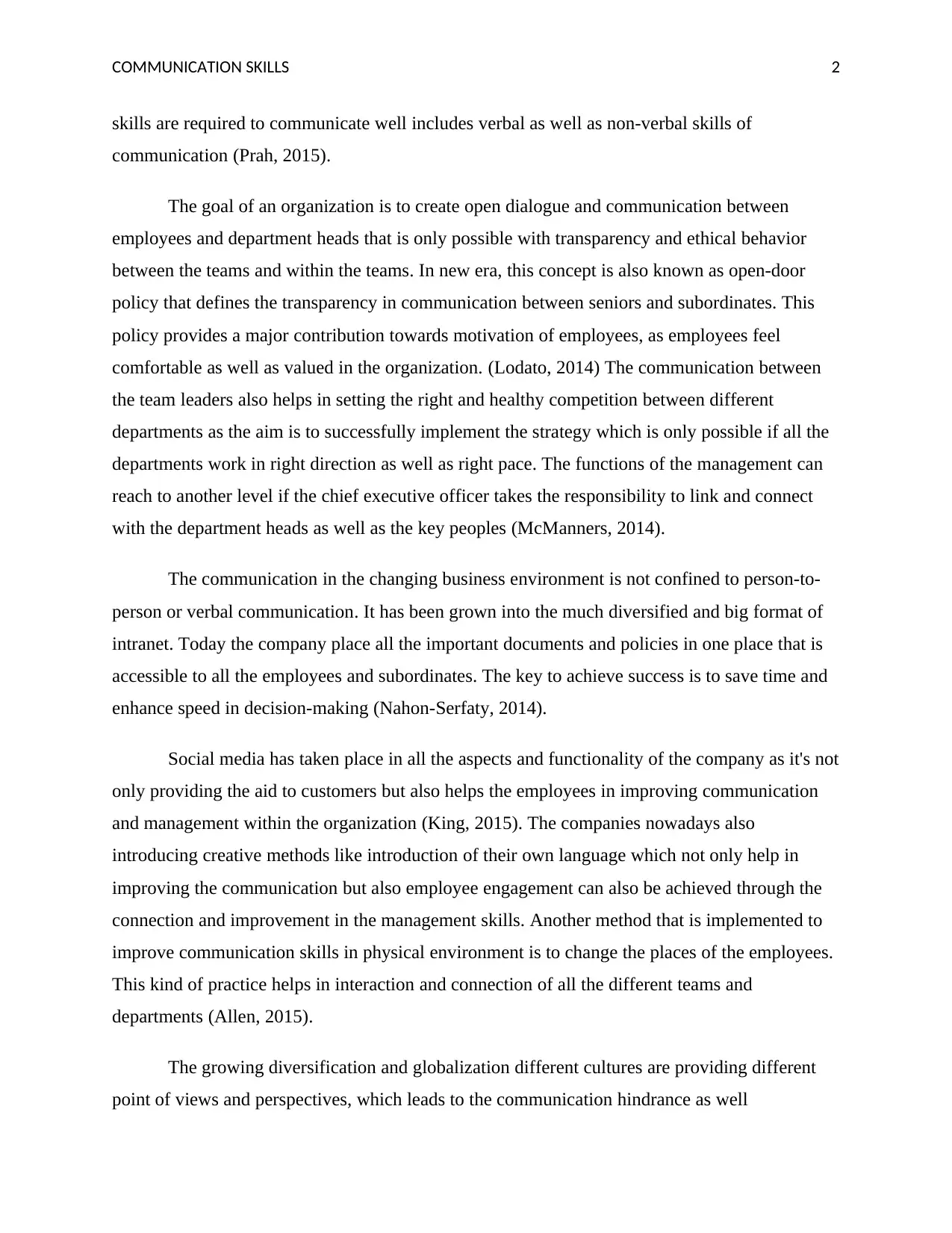
COMMUNICATION SKILLS 2
skills are required to communicate well includes verbal as well as non-verbal skills of
communication (Prah, 2015).
The goal of an organization is to create open dialogue and communication between
employees and department heads that is only possible with transparency and ethical behavior
between the teams and within the teams. In new era, this concept is also known as open-door
policy that defines the transparency in communication between seniors and subordinates. This
policy provides a major contribution towards motivation of employees, as employees feel
comfortable as well as valued in the organization. (Lodato, 2014) The communication between
the team leaders also helps in setting the right and healthy competition between different
departments as the aim is to successfully implement the strategy which is only possible if all the
departments work in right direction as well as right pace. The functions of the management can
reach to another level if the chief executive officer takes the responsibility to link and connect
with the department heads as well as the key peoples (McManners, 2014).
The communication in the changing business environment is not confined to person-to-
person or verbal communication. It has been grown into the much diversified and big format of
intranet. Today the company place all the important documents and policies in one place that is
accessible to all the employees and subordinates. The key to achieve success is to save time and
enhance speed in decision-making (Nahon-Serfaty, 2014).
Social media has taken place in all the aspects and functionality of the company as it's not
only providing the aid to customers but also helps the employees in improving communication
and management within the organization (King, 2015). The companies nowadays also
introducing creative methods like introduction of their own language which not only help in
improving the communication but also employee engagement can also be achieved through the
connection and improvement in the management skills. Another method that is implemented to
improve communication skills in physical environment is to change the places of the employees.
This kind of practice helps in interaction and connection of all the different teams and
departments (Allen, 2015).
The growing diversification and globalization different cultures are providing different
point of views and perspectives, which leads to the communication hindrance as well
skills are required to communicate well includes verbal as well as non-verbal skills of
communication (Prah, 2015).
The goal of an organization is to create open dialogue and communication between
employees and department heads that is only possible with transparency and ethical behavior
between the teams and within the teams. In new era, this concept is also known as open-door
policy that defines the transparency in communication between seniors and subordinates. This
policy provides a major contribution towards motivation of employees, as employees feel
comfortable as well as valued in the organization. (Lodato, 2014) The communication between
the team leaders also helps in setting the right and healthy competition between different
departments as the aim is to successfully implement the strategy which is only possible if all the
departments work in right direction as well as right pace. The functions of the management can
reach to another level if the chief executive officer takes the responsibility to link and connect
with the department heads as well as the key peoples (McManners, 2014).
The communication in the changing business environment is not confined to person-to-
person or verbal communication. It has been grown into the much diversified and big format of
intranet. Today the company place all the important documents and policies in one place that is
accessible to all the employees and subordinates. The key to achieve success is to save time and
enhance speed in decision-making (Nahon-Serfaty, 2014).
Social media has taken place in all the aspects and functionality of the company as it's not
only providing the aid to customers but also helps the employees in improving communication
and management within the organization (King, 2015). The companies nowadays also
introducing creative methods like introduction of their own language which not only help in
improving the communication but also employee engagement can also be achieved through the
connection and improvement in the management skills. Another method that is implemented to
improve communication skills in physical environment is to change the places of the employees.
This kind of practice helps in interaction and connection of all the different teams and
departments (Allen, 2015).
The growing diversification and globalization different cultures are providing different
point of views and perspectives, which leads to the communication hindrance as well
⊘ This is a preview!⊘
Do you want full access?
Subscribe today to unlock all pages.

Trusted by 1+ million students worldwide
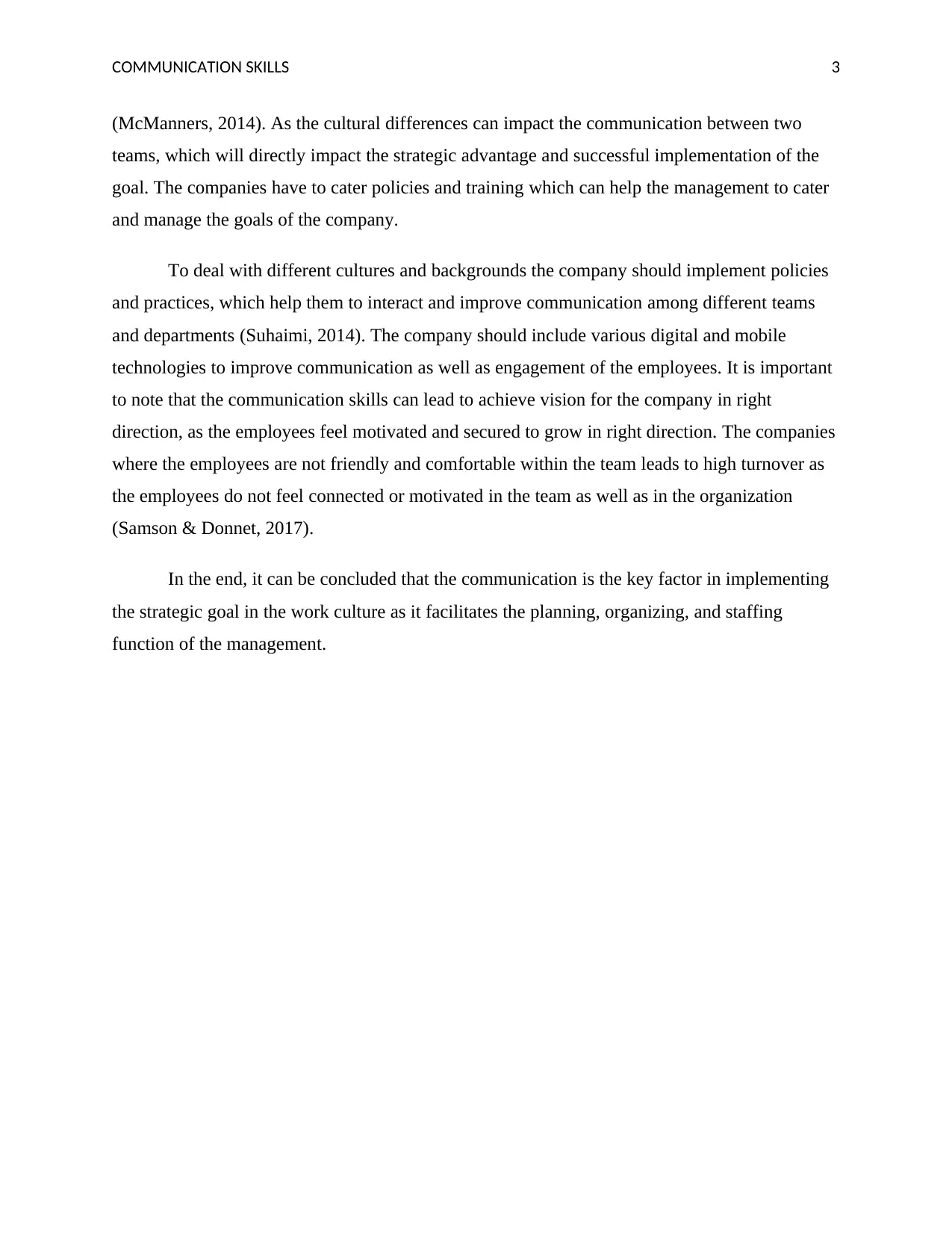
COMMUNICATION SKILLS 3
(McManners, 2014). As the cultural differences can impact the communication between two
teams, which will directly impact the strategic advantage and successful implementation of the
goal. The companies have to cater policies and training which can help the management to cater
and manage the goals of the company.
To deal with different cultures and backgrounds the company should implement policies
and practices, which help them to interact and improve communication among different teams
and departments (Suhaimi, 2014). The company should include various digital and mobile
technologies to improve communication as well as engagement of the employees. It is important
to note that the communication skills can lead to achieve vision for the company in right
direction, as the employees feel motivated and secured to grow in right direction. The companies
where the employees are not friendly and comfortable within the team leads to high turnover as
the employees do not feel connected or motivated in the team as well as in the organization
(Samson & Donnet, 2017).
In the end, it can be concluded that the communication is the key factor in implementing
the strategic goal in the work culture as it facilitates the planning, organizing, and staffing
function of the management.
(McManners, 2014). As the cultural differences can impact the communication between two
teams, which will directly impact the strategic advantage and successful implementation of the
goal. The companies have to cater policies and training which can help the management to cater
and manage the goals of the company.
To deal with different cultures and backgrounds the company should implement policies
and practices, which help them to interact and improve communication among different teams
and departments (Suhaimi, 2014). The company should include various digital and mobile
technologies to improve communication as well as engagement of the employees. It is important
to note that the communication skills can lead to achieve vision for the company in right
direction, as the employees feel motivated and secured to grow in right direction. The companies
where the employees are not friendly and comfortable within the team leads to high turnover as
the employees do not feel connected or motivated in the team as well as in the organization
(Samson & Donnet, 2017).
In the end, it can be concluded that the communication is the key factor in implementing
the strategic goal in the work culture as it facilitates the planning, organizing, and staffing
function of the management.
Paraphrase This Document
Need a fresh take? Get an instant paraphrase of this document with our AI Paraphraser
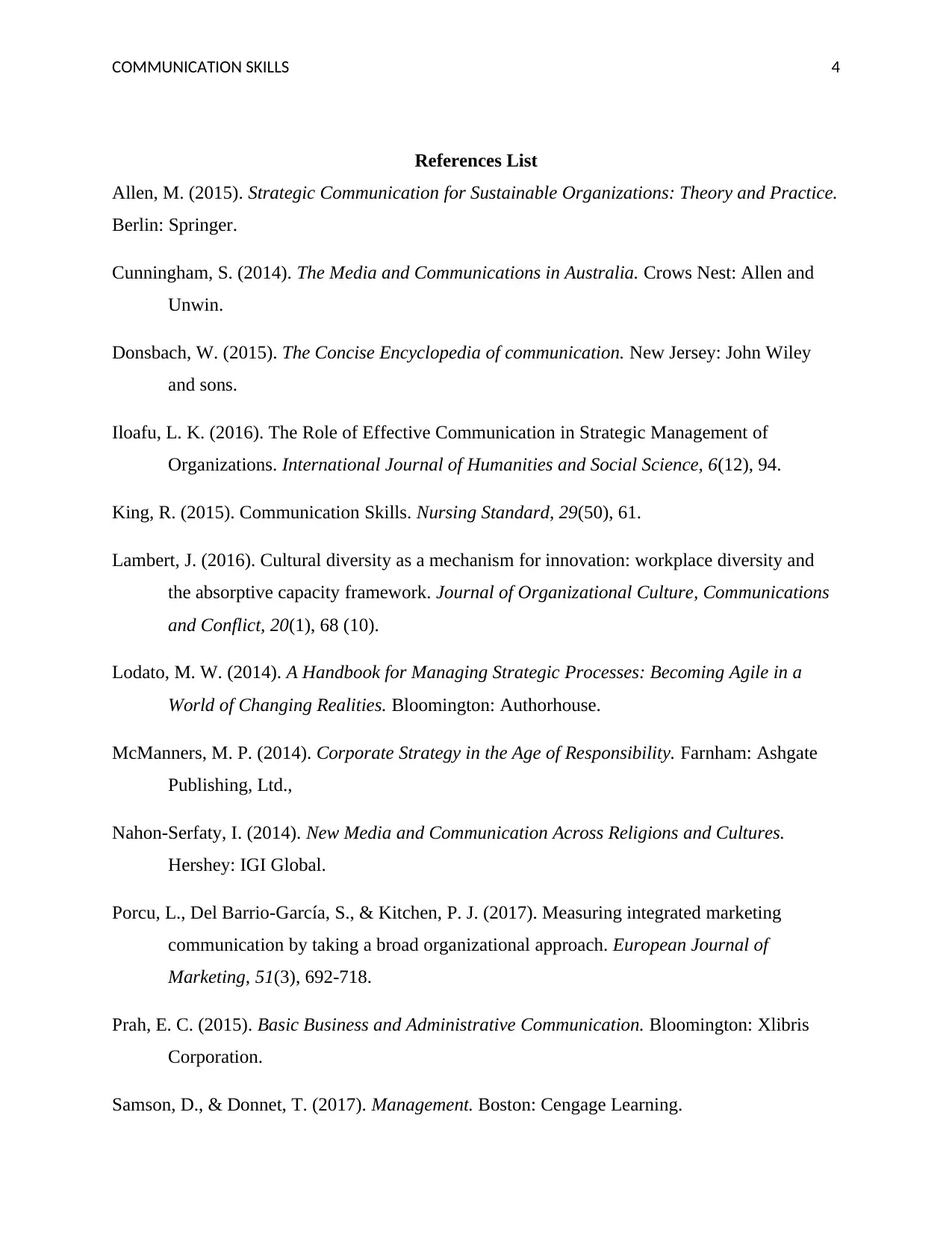
COMMUNICATION SKILLS 4
References List
Allen, M. (2015). Strategic Communication for Sustainable Organizations: Theory and Practice.
Berlin: Springer.
Cunningham, S. (2014). The Media and Communications in Australia. Crows Nest: Allen and
Unwin.
Donsbach, W. (2015). The Concise Encyclopedia of communication. New Jersey: John Wiley
and sons.
Iloafu, L. K. (2016). The Role of Effective Communication in Strategic Management of
Organizations. International Journal of Humanities and Social Science, 6(12), 94.
King, R. (2015). Communication Skills. Nursing Standard, 29(50), 61.
Lambert, J. (2016). Cultural diversity as a mechanism for innovation: workplace diversity and
the absorptive capacity framework. Journal of Organizational Culture, Communications
and Conflict, 20(1), 68 (10).
Lodato, M. W. (2014). A Handbook for Managing Strategic Processes: Becoming Agile in a
World of Changing Realities. Bloomington: Authorhouse.
McManners, M. P. (2014). Corporate Strategy in the Age of Responsibility. Farnham: Ashgate
Publishing, Ltd.,
Nahon-Serfaty, I. (2014). New Media and Communication Across Religions and Cultures.
Hershey: IGI Global.
Porcu, L., Del Barrio-García, S., & Kitchen, P. J. (2017). Measuring integrated marketing
communication by taking a broad organizational approach. European Journal of
Marketing, 51(3), 692-718.
Prah, E. C. (2015). Basic Business and Administrative Communication. Bloomington: Xlibris
Corporation.
Samson, D., & Donnet, T. (2017). Management. Boston: Cengage Learning.
References List
Allen, M. (2015). Strategic Communication for Sustainable Organizations: Theory and Practice.
Berlin: Springer.
Cunningham, S. (2014). The Media and Communications in Australia. Crows Nest: Allen and
Unwin.
Donsbach, W. (2015). The Concise Encyclopedia of communication. New Jersey: John Wiley
and sons.
Iloafu, L. K. (2016). The Role of Effective Communication in Strategic Management of
Organizations. International Journal of Humanities and Social Science, 6(12), 94.
King, R. (2015). Communication Skills. Nursing Standard, 29(50), 61.
Lambert, J. (2016). Cultural diversity as a mechanism for innovation: workplace diversity and
the absorptive capacity framework. Journal of Organizational Culture, Communications
and Conflict, 20(1), 68 (10).
Lodato, M. W. (2014). A Handbook for Managing Strategic Processes: Becoming Agile in a
World of Changing Realities. Bloomington: Authorhouse.
McManners, M. P. (2014). Corporate Strategy in the Age of Responsibility. Farnham: Ashgate
Publishing, Ltd.,
Nahon-Serfaty, I. (2014). New Media and Communication Across Religions and Cultures.
Hershey: IGI Global.
Porcu, L., Del Barrio-García, S., & Kitchen, P. J. (2017). Measuring integrated marketing
communication by taking a broad organizational approach. European Journal of
Marketing, 51(3), 692-718.
Prah, E. C. (2015). Basic Business and Administrative Communication. Bloomington: Xlibris
Corporation.
Samson, D., & Donnet, T. (2017). Management. Boston: Cengage Learning.
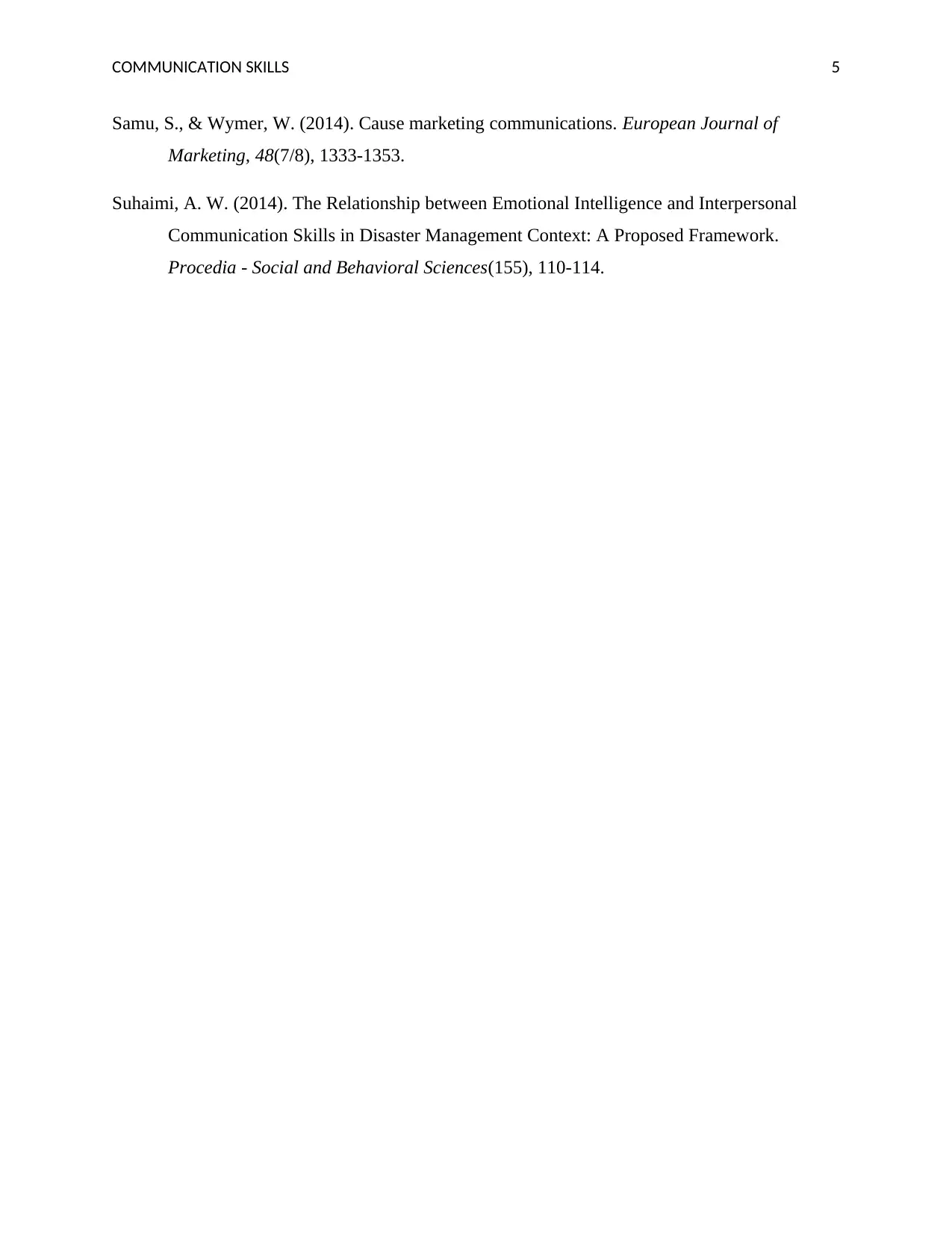
COMMUNICATION SKILLS 5
Samu, S., & Wymer, W. (2014). Cause marketing communications. European Journal of
Marketing, 48(7/8), 1333-1353.
Suhaimi, A. W. (2014). The Relationship between Emotional Intelligence and Interpersonal
Communication Skills in Disaster Management Context: A Proposed Framework.
Procedia - Social and Behavioral Sciences(155), 110-114.
Samu, S., & Wymer, W. (2014). Cause marketing communications. European Journal of
Marketing, 48(7/8), 1333-1353.
Suhaimi, A. W. (2014). The Relationship between Emotional Intelligence and Interpersonal
Communication Skills in Disaster Management Context: A Proposed Framework.
Procedia - Social and Behavioral Sciences(155), 110-114.
⊘ This is a preview!⊘
Do you want full access?
Subscribe today to unlock all pages.

Trusted by 1+ million students worldwide
1 out of 6
Related Documents
Your All-in-One AI-Powered Toolkit for Academic Success.
+13062052269
info@desklib.com
Available 24*7 on WhatsApp / Email
![[object Object]](/_next/static/media/star-bottom.7253800d.svg)
Unlock your academic potential
Copyright © 2020–2025 A2Z Services. All Rights Reserved. Developed and managed by ZUCOL.





